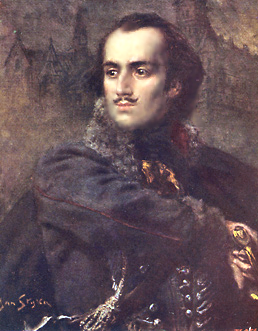
Count Pulaski was born in the province of Podolia, Poland and died fighting in the American Revolution. By an act of The United States Congress, each October 11th is observed as Pulaski Day.
Count Casimir Pulaski was buried in Monterey Park in Savannah. A historical marker in this park gives the following account of Pulaski’s death and burial. “The great Polish patriot to whose memory this monument is erected was mortally wounded approximately one-half mile northwest of this spot during the assault by the French and American forces on the British lines around Savannah, October 9, 1779. General Pulaski was struck by grape shot as he rode forward with customary ardor from where his cavalry was stationed to rally the disorganized Allied columns. The fatal ball which was removed from his thigh by Dr. James Lynah of South Carolina is in possession of the Georgia Historical Society of Savannah.
Doubt and uncertainly exists as to where Pulaski died and as to his burial-place. A contemporary Charleston, S.C. newspaper item and other sources indicate that he died aboard a ship bound for that port. It was generally believed that he was buried at sea.
A tradition persisted, however, that General Pulaski died at Greenwich Plantation near Savannah and that he was buried there. When the monument here was under erection the grave at Greenwich was opened. The remains found there confirmed, in the opinion of physicians, to a man of Pulaski’s age and stature and were re-interred beneath this monument in a metallic case in 1854.” (75 years after his death)
Count Casimir Pulaski
Age: 31 years
Grade: Brigadier General
Unit: Pulaski’s Legion
Time in Service: Poland 6 yrs, America 3 yrs.
Campaigns: Brandywine 1777
Battle of Georgetown 1777
Little Egg Harbor 1778
Charleston 1779
Siege of Savannah 1779
Description: Pulaski’s 200 cavalry were suppose to lead the American forces in Spring Hill approach, pull to the left and wait for the fort’s wall to be breached, then charge through the gap. But as French and Americans became entangled, Polish General Pulaski tried to force his way between Spring Hill and the defensive works to the west. He received a mortal wound in his leg and died two days later.
Died: October 11, 1779
